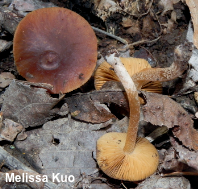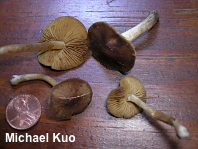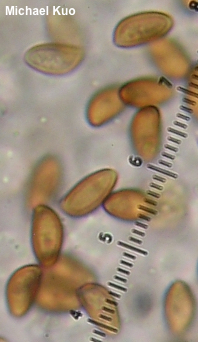| Major Groups > Gilled Mushrooms > Dark-Spored > Conocybe & Pholiotina > Conocybe tuxtlaensis |

|
[ Basidiomycota > Agaricales > Bolbitiaceae > Conocybe . . . ] Conocybe tuxtlaensis by Michael Kuo, September 2020 For a Conocybe, Conocybe tuxtlaensis doesn't have much of a cono cybe ("cone-shaped head," in Latin). There are a few species in the genus that don't live up to the genus name, and this is one of them. In fact I had no idea it was a Conocybe until I put the thing under the microscope and saw the tell-tale, bowling-pin-shaped cheilocystidia on the edges of the gills. Why I ever collected this LBM (Little Brown Mushroom) is beyond me. In my defense it was March, and I was pretty eager to collect any mushroom after a long, mushroomless winter. But LBMs usually mean hours of tedious microscope work and research, and this one was no exception—although I waited 8 years before I pulled the dried collection out for study, thinking it would be an Agrocybe. Oops. Anyway, the identifying features include the spores (see measurements below), the 4-spored basidia, the aforementioned cheilocystidia and, especially, the caulocystidia, which are a mixture of blobby elements and bowling-pin-shaped elements. Yes, "blobby" is a highly technical term, and I have used it with precision. Conocybe tuxlaensis (without the T) is an orthographic variant. Description: Ecology: Saprobic; growing alone or gregariously on the ground under hardwoods; spring and summer; North American distribution uncertain (previously reported from Veracruz, Mexico); also reported from Europe and South America. The illustrated and described collection is from Illinois. Cap: 2–3 cm; convex, becoming planoconvex; thin; moist; bald; dark orangish brown, fading markedly to medium brown or yellowish tan, but retaining a darker center; margin becoming finely lined. Gills: Narrowly attached to the stem; close; short-gills frequent; yellowish becoming orangish brown. Stem: 4–5 cm long; 2–3 mm thick; fragile; equal above a slight basal bulb; brownish to brown; white-flaky-pruinose over upper half or more; basal mycelium white. Flesh: Insubstantial; watery brownish; unchanging. Odor: Not distinctive. Chemical Reactions: KOH on cap surface negative. Spore Print: Medium brown. Microscopic Features: Spores 6.5–8 x 3.5–4 µm; ellipsoid to subamygdaliform; smooth; bright orange-brown in KOH. Basidia 4-sterigmate. Pleurocystidia not found. Cheilocystidia 25–30 x 6–8 µm; lecythiform, with a severely narrowed neck about 1–2 x 1 µm, between a clavate to ellipsoid bottom portion and a globose head 3.5–5 µm wide; thin-walled; smooth; hyaline in KOH. Pileipellis hymeniform; terminal cells obpyriform to abruptly clavate; smooth; brownish in KOH. Caulocystidia 20–25 x 8–10 µm; some hairlike, widely clavate, or subellipsoid, but most lecythiform with the top part 3–4 µm across and an extended narrowed neck; walls about 0.5 µm thick; smooth; hyaline in KOH. REFERENCES: Singer 1989. (Hausknecht et al., 2004; Arnolds, 2005; Hausknecht & Vesterholt, 2018.) Herb. Kuo 03171202. This site contains no information about the edibility or toxicity of mushrooms. |
© MushroomExpert.Com |
|
Cite this page as: Kuo, M. (2020, September). Conocybe tuxtlaensis. Retrieved from the MushroomExpert.Com Web site: http://www.mushroomexpert.com/conocybe_tuxtlaensis.html |




